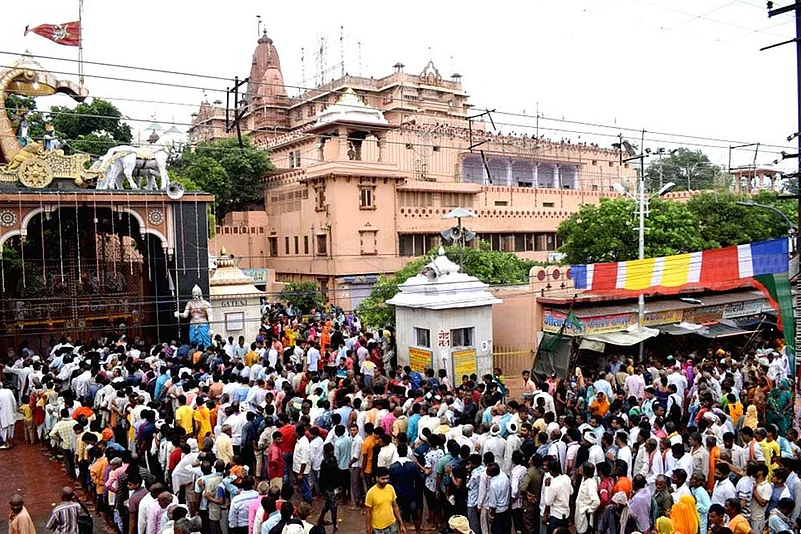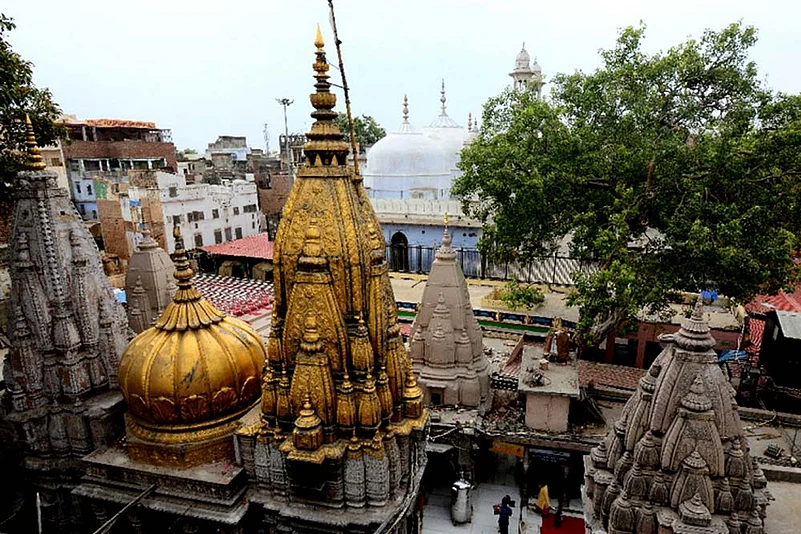The narrow alleys leading up to Varanasi’s Kashi Viswanath temple, seething with humanity, materiel, holy cattle and the decaying detritus of religious offering, is a microcosm of Varanasi—ancient, unchanging and unflappable, one of the world’s great pilgrimage towns. Even Covid-19 restrictions haven’t silenced its historic lanes: over 100 people are engaged in the ongoing work of the Kashi Viswanath Corridor project, a five lakh square feet area being developed to provide access to the temple. Loud, juddering earth-movers and heavy dumpers often drown out the sound of temple bells and conches in the labyrinthine quarter.
New structures have sprouted in the lanes, replacing some heritage buildings, as serpentine bylanes are widened for spacious pathways from the three ghats on the Ganga to the Vishwanath temple. The corridor, a pet project of Prime Minister Narendra Modi, will cost an estimated Rs 600-crores, accommodate lakhs of devotees and enable a direct view of the temple from the ghats.
As Kashi prepares to welcome more visitors, over a hundred kilometres away, Ayodhya, another ancient town, has just seen the laying of the foundation for the Ram temple at Ram Janmabhoomi. The long-drawn Janmabhoomi-Babri Masjid land title case was settled by the Supreme Court in November last year.
However, the Ram temple in Ayodhya might just herald a new age of temple building—new temples in Kashi and Mathura have been a top agenda of the Vishva Hindu Parishad (VHP) and other Hindu outfits for long. With renewed calls by some Hindu fringe groups for ‘reclaiming’ temples in Kashi and Mathura getting shriller, there is growing apprehension in Varanasi’s Muslim community. After the SC verdict in favour of a Ram temple in Ayodhya, some fringe groups in Varanasi have also called for the ‘liberation of Kashi and Mathura’ temples.
There seems to be votaries for the revival of the Kashi-Mathura project in the Bharatiya Janta Party (BJP). Senior leader Vinay Katiyar tells Outlook that constructing temples in Kashi and Mathura has always been in the party’s scheme of things. “Many discussions have taken place in this regard in the party. The disputed sites of Kashi Viswanath temple and Krishna Janmabhoomi temple in Mathura have always been on our agenda. Now that our Ayodhya mission is fulfilled, Kashi and Mathura will happen,” says Katiyar.
Meanwhile, the corridor project has exacerbated Muslims’ fear about the fate of the 17th-century Gyanvapi mosque, which is situated in the same complex as the Kashi Vishwanath temple. According to historians, the mosque was built by Aurangzeb on the ruins of the original Kashi Vishwanath temple, which was demolished and rebuilt several times. For some, the circumstances seem ripe for a replay of events that unfolded in Ayodhya since 1990.
Sanjeev Ratan Mishra, a resident of Varanasi, is not enthused about a Ram temple in Ayodhya. “Why to build a temple in Ayodhya when they destroyed hundreds of temples in Kashi, the abode of Lord Shiv?” he asks. Mishra is among the hundreds who lost their residential and commercial properties during the demolition drive for the corridor project, which was launched two years ago. Mishra recounts how his shop, set up in 1937 by his great grandfather, was demolished overnight. Though he received monetary compensation after going to court, Mishra still struggles to set up his business and a construct a new house.

The Krishna Janmabhoomi temple complex in Mathura.
Mishra says that at least 300 buildings have been razed, including heritage structures and shops, leaving thousands homeless and in penury. The resentment is echoed by most Hindus in the vicinity. Significantly, they also lament about many temples being destroyed and idols buried under the rubble. Kulpati Tiwari, mahant of the Vishwanath Temple, is himself an aggrieved party. He says the demolition was an attack on Kashi’s heritage and that he was forced to leave his house. “My house is gone. Why only Hindus have to bear the brunt? There is no one to hear us,” he says.
Though properties owned by Muslims were not disturbed during the demolition, minor flare-ups did erupt, which were settled later. S.M. Yasin, general secretary of the Anjuman Intizamiya Masjid (AIM), which manages the Gyanvapi mosque, says that though his community wasn’t affected and that the mosque is well protected since 1993, fear still persists.
For many Muslims in Kashi, the slogan ‘Ayodhya to sirf jhanki hai, Kashi, Mathura baki hai’ (Ayodhya is a trailer, Kashi and Mathura are left), rings fresh in memories. After 28 years, nobody wants a repeat of the events of December 6, 1992, they say. “We are apprehensive. The way the government machinery and other bodies work, it doesn’t give us confidence,” says Yasin, adding that the Gyanvapi mosque is at an advantage since prayers have been performed on a daily basis for many years.
The fear of the Muslim community is compounded by a petition in the Supreme Court in June 2020 challenging the ‘Place of worship Act, 1991’, which protects the ‘religious character of a place of worship’ as it existed on August 15, 1947. The petition, filed by Lucknow-based Hindu outfit Vishwa Bhadra Pujari Purohit Mahasangh, seeks to open a litigation route to reclaim the Gyanvapi mosque and the Shahi Idgah mosque that stands next to Mathura’s Krishna Janmabhoomi temple. In response, Muslim outfit Jamiat-Ulema-e-Hind and Peace Party has approached the SC with pleas not to entertain petitions in the Kashi/ Mathura row.
However, the VHP, which was at the forefront of the Ram Janmabhoomi agitation, seems to be distancing itself from the plans on an Ayodhya II. VHP’s central joint general secretary, Surendra Jain, tells Outlook that the party is committed to building the grand Ram temple at the moment. “VHP has no connection with the petition challenging the 1991 Act. Right now, we are preparing to construct Ram temple. Our effort now is to construct the temple at the earliest. We are not thinking about Kashi or Mathura now,” says Jain.
The P.V. Narasimha Rao government passed the Place of Worship Act in 1991, when the country was in the grip of communal tension following the Babri Masjid-Ram Janmabhoomi dispute. The Act came into being after VHP and other Hindu outfits targeted the Gyanvapi and the Shahi Idgah mosques.
However, the BJP’s ideological parent body, the Rashtriya Swayamsevak Sangh (RSS), which has in the past been vocal about the temple projects in Kashi and Mathura, seems to be on the backfoot. A top RSS leader tells Outlook that it is not desirable to talk about a petition in the SC, which hasn’t considered by the court. “We haven’t taken a stand yet on Kashi and Mathura temple construction. In the case of Ram Janmabhoomi agitation, some sants started it and the Sangh passed a resolution and supported the agitation. We became a part of it later. That is a separate issue. Right now our focus is on Ayodhya. In the case of Kashi and Mathura, nobody knows what will happen next,” he says.
Despite the protection provided by the 1991 Act, the Gyanvapi mosque has been embroiled in litigation since 1991 itself. That year, an RSS worker filed a case on behalf of the ‘Swayambhu Lord Vishwanath’ against the AIM, demanding that the mosque site be handed over to the Kashi Vishwanath temple. In 1998, the court passed an order summoning witnesses to check if the mosque stood at the same spot on August 15, 1947. The AIM approached the Allahabad High Court seeking a stay on the civil court’s proceedings; it was granted in 2018. “From 1991, a case is going on in district court. We have secured a stay on the petition. But I don’t understand why the SC is entertaining such cases when the 1991 Act is there,” says Yasin.
Though the dispute has been a long-drawn one, Rajendra Tiwari, a former priest of Kashi Vishwanath, believes that the communal harmony that has characterised the ancient city will remain unchanged. “They say Aurangazeb demolished the temple and built a mosque. BJP is using this for political purposes,” says Tiwari.
Wading into the row, Asaduddin Owaisi, president of All India Majlis-e-Ittehad-ul-Muslimeen (AIMIM), says that the BJP government may even repeal the 1991 Act if they want. “In the Ayodhya verdict, the SC praised the 1991 Act. If that’s the case, why is the case about the Kashi temple still pending? In fact, the other side has filed a petition in the district court that they do not accept this Act,” says Owaisi. In the light of the corridor project, the apprehension about a repeat of Babri Masjid is justified, he says.
The other potential flashpoint is Mathura’s Shahi Idgah mosque, next to the Krishna Janmabhoomi temple complex. It has been claimed that Aurangzeb demolished the Keshavnath temple and built the Shahi Idgah mosque. Zafaryab Jilani, who represented the Muslim parties in the Ayodhya title suit contends that the management rights of the mosque were accorded to the Muslim committee under an agreement reached in 1968 between the Shahi Idgah committee and the Sri Krishnabhoomi Trust. “A petition has been filed in Allahabad HC in the ’90s, saying that there should be only weekly prayers conducted in the mosque. I do not know the fate of the petition,” says Gilani.
As cases remain pending before the court, Gilani says that the Muslim community reposes its faith in the Constitution to protect the mosques. “They got Ayodhya from the SC after 70 years. It’s not easy to get these two. We will contest it. No mosque can be surrendered. If it’s a mosque, it will remain a mosque. Every effort will be made to protect it,” he says.
















